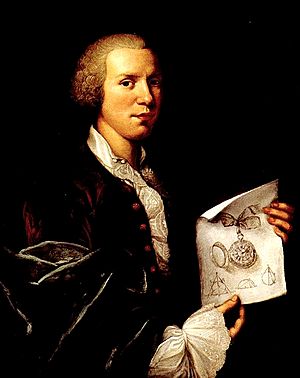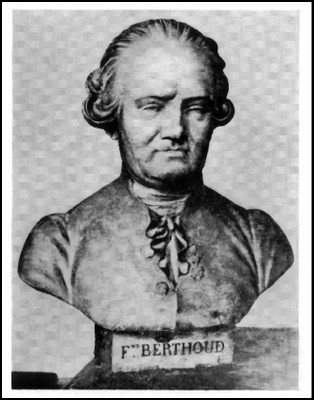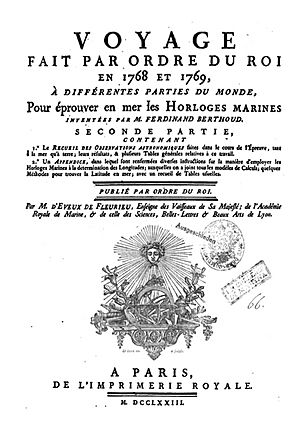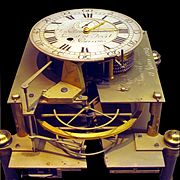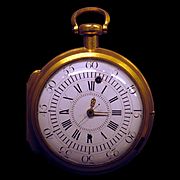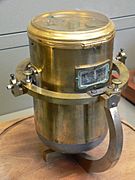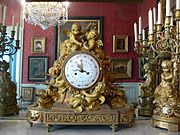Ferdinand Berthoud facts for kids
Ferdinand Berthoud (born March 18, 1727, in Plancemont-sur-Couvet, Switzerland; died June 20, 1807, in Groslay, France) was a brilliant scientist and watchmaker. He became a master watchmaker in Paris in 1753. Berthoud was so skilled that he became the "Horologist-Mechanic" (clockmaker and mechanic) for the King and the Navy. He created many amazing inventions, especially marine chronometers, which are super accurate clocks for ships.
Contents
A Young Watchmaker's Journey
Ferdinand Berthoud was born on March 18, 1727, in a small town called Plancemont, in what is now Switzerland. His family was well-known for making watches and clocks.
His father, Jean Berthoud, was a master carpenter and architect. Ferdinand's mother was Judith Berthoud.
Ferdinand had several brothers and sisters. His brother Jean-Henry was also an expert watchmaker. His nephews, Pierre Louis and Henri, later worked closely with him.
In 1741, when Ferdinand was just 14, he started learning clockmaking from his brother Jean-Henry. He also received a good science education. By April 13, 1745, he had finished his training and earned his watchmaking certificate.
In 1745, at age 18, Ferdinand moved to Paris. He wanted to become an even better watchmaker. He worked with many master watchmakers there. Some say he even worked for Julien Le Roy, where he learned very quickly.
On December 4, 1753, the King of France gave Ferdinand a special permission. He became a master watchmaker at only 26 years old! This was very unusual at the time.
From 1755, Ferdinand Berthoud started writing articles about watchmaking. These were for a huge book called the Encyclopédie méthodique. Famous thinkers like Diderot and d'Alembert were in charge of this book.
In 1759, Ferdinand published his first book. It was called L'Art de conduire et de régler les pendules et les montres. This book taught people how to use and adjust clocks and watches.
Testing Sea Clocks
In 1763, the King sent Ferdinand to London. His mission was to check out a special sea clock called H4. This clock was made by a famous English watchmaker named John Harrison. But Harrison only showed Ferdinand his older clocks. He refused to show the amazing H4.
Even though he didn't see the H4, Ferdinand's trip was still important. His books and inventions were well-known. Because of this, he was chosen to be a member of the Royal Society in London in 1764. This was a big honor!
In 1764, the French Academy asked two of its members to test Ferdinand's own sea watch. They tested it on a ship called L'Hirondelle. Ferdinand was there to see the tests himself.
Ferdinand went to London again in 1765. He tried to meet Harrison again, but Harrison still wouldn't show him the H4. Harrison knew Ferdinand could use the ideas to help the French Navy. Another English watchmaker, Thomas Mudge, explained how the H4 worked to Ferdinand.
On May 7, 1766, Ferdinand wrote to the Minister of the Navy. He explained his plan to build two new sea clocks, Numbers 6 and 8. He asked for money to help him build them. He also wanted the title of "Horologist-Mechanic by appointment to the King and the Navy." He wanted to focus on making sea clocks to help ships find their way.
The King agreed to Ferdinand's plan on July 24, 1766. He decided to pay for the two new sea clocks.
To make sure the new sea clocks worked well, they were tested. On November 3, 1768, Sea Clocks numbers 6 and 8 were given to Charles-Pierre Claret. He was an explorer and King's lieutenant. He took the clocks on a ship called Isis. They sailed from Rochefort to Santo Domingo and back. The trip lasted ten months, and the clocks worked perfectly!
In 1769, Ferdinand asked his nephew, Pierre-Louis Berthoud, to come to Paris. Pierre-Louis was a talented young watchmaker. He helped Ferdinand make and fix the sea clocks for the French and Spanish navies.
On April 1, 1770, Ferdinand Berthoud officially received his special title. He became "Horologist-Mechanic by appointment to the King and the Navy." He also got money each year and was in charge of checking how sea clocks were built. The King even ordered 20 more sea clocks from him!
Ferdinand Berthoud's clocks became very popular. They were used on many ships for tests and mapping voyages.
In 1771, a scientist named Jean-Charles de Borda used Ferdinand's chronometers. He tested them on a ship called Flore during a trip from the Canary Islands to the Caribbean.
On August 1, 1785, Ferdinand gave five clocks to Captain Jean-François de Galaup, comte de Lapérouse. Lapérouse was leaving on a trip around the world. He wanted to explore the Pacific Ocean, following the discoveries of James Cook. Sadly, the clocks were lost at sea in 1788 when Lapérouse's ship, the Astrolabe, sank.
In 1791, Ferdinand supplied four more marine chronometers. These were for Antoine Bruni d'Entrecasteaux. He was going on an expedition to search for Lapérouse.
In 1795, Ferdinand was chosen as a top member of France's National Institute. After the French Revolution, he moved into the famous Louvre building. He kept working on his clocks and taking care of the sea clocks. His most important project was publishing his big book, Histoire de la Mesure du temps (1802).
On July 17, 1804, Napoleon honored Ferdinand. He made him a Knight of the Legion of Honour.
Ferdinand Berthoud passed away on June 20, 1807, at the age of 80. He is buried in Groslay, France, where a monument remembers him.
Berthoud's Amazing Inventions and Writings
In 1752, when he was 25, Ferdinand Berthoud showed a special clock to the Royal Academy of Sciences. This showed how incredibly skilled he was at making watches. Important scientists wrote a great report about his work.
Ferdinand often sealed his new ideas in envelopes and gave them to the French Royal Academy of Sciences. This way, his inventions were officially recorded. On November 20, 1754, he filed his first plan for a sea clock. This envelope was not opened until 1976!
On December 13, 1760, Ferdinand shared his ideas for building a marine clock. This was for his famous Sea Clock Number 1. He finished building it in early 1761.
Ferdinand Berthoud loved to do research and share what he learned. He published many books and articles. This helped him become well-known in the science world. He wrote many articles for the Encyclopédie méthodique.
In 1759, he published his popular book, L'Art de conduire et de régler les pendules et les montres. In 1763, his longer book, L'Essai sur l'horlogerie, was also very successful. It was translated into many languages.
The year 1763 was a big turning point for Berthoud. From then on, he focused on improving navigation at sea. He opened two sealed envelopes he had filed earlier. These described his Sea Clock number 17.
Ferdinand always had new projects and detailed plans. For example, he suggested building two sea watches on May 7, 1766. These were Numbers 6 and 8. You can still see them today at the French Museum of Arts and Trades. After these clocks worked well, Ferdinand received his special title from the King in 1770.
In 1773, Ferdinand Berthoud published his Traité des horloges marines. This book was the first of its kind. It explained how to build every part of a sea clock. This book made his work very famous, especially compared to other clockmakers like Harrison.
Two years later, in 1775, Ferdinand published another book. It was about finding longitude at sea using marine clocks.
In 1787, Berthoud published De la Mesure du Temps. This book was about measuring time and how to build smaller, more accurate clocks. It was even translated into German.
In 1792, Ferdinand Berthoud published his Traité des montres à Longitudes. In this book, he shared ideas for making clocks even more precise.
Four years later, in 1796, Berthoud published a follow-up book. It described how to build portable clocks for long sea voyages.
In 1802, Ferdinand Berthoud published one of his most important works: Histoire de la mesure du temps par les horloges. This book showed his amazing knowledge of how clocks work.
In 1807, the year he died, Berthoud published his final work. It was a supplement to his book on longitude watches.
Ferdinand Berthoud was a determined experimenter and a very skilled craftsman. He loved to invent things and share his knowledge. He not only helped watchmaking advance, but he also made sure that super accurate clocks were used in science. He was the only watchmaker of his time to publish all his research in a detailed way. He did more experiments than any other watchmaker!
Ferdinand Berthoud created an incredible amount of work. This included sea chronometers, fancy watches and clocks, special tools, and science instruments. He also published many books and papers, totaling over 4,000 pages!
All the awards and honors he received, from the time of King Louis XV to Napoleon, show how important he was. His work is still recognized today for its accuracy and importance in history.
Main clocks
- Main clocks
Where to See His Work
An exhibition about Berthoud was held in Switzerland in 1984 and in France in 1985.
You can also see Ferdinand Berthoud's work permanently in many museums around the world. Some of these include the National Conservatory of Arts and Crafts in France, the International Museum of Horology in Switzerland, and the British Museum in London.
See also
 In Spanish: Ferdinand Berthoud para niños
In Spanish: Ferdinand Berthoud para niños
Related articles
- John Harrison
- History of watchmaking
- Louis Berthoud
- Pierre Le Roy


